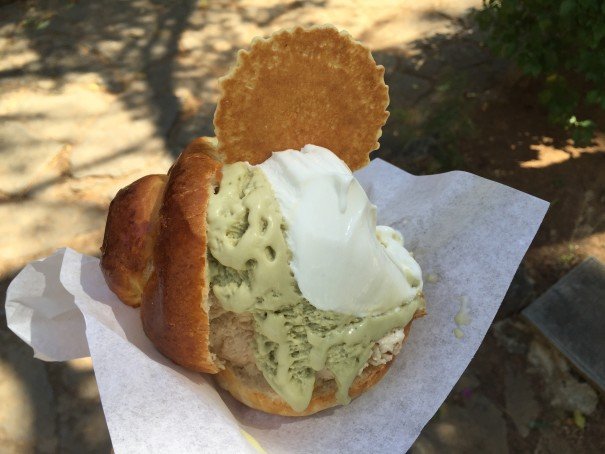
Yes, a Thousand Times Yes, to Ice Cream in a Bread Bowl for Breakfast

Yes, a Thousand Times Yes, to Ice Cream in a Bread Bowl for Breakfast
Gelato con Brioche in Palermo
It’s 10:30am on a Tuesday and I am eating an ice-cream burger the size of my face. Despite the gargantuan proportions involved, this is a delicate procedure: the salty, sweet brioche must be handled carefully, allowing the steady consumption of gelato without losing trickles to the Sicilian spring heat. The operation is so sensitive, in fact, that I fear I look somewhat ridiculous: cradling the glossy bronze bun while turning my head this way and that, negotiating the mercurial subtleties of its cool contents with my tongue. The whole thing feels vaguely indecent. Not that anyone else in this public park seems to mind; this is Palermo, after all, and gelato con brioche is a respectable—even venerable—breakfast option.
Besides, Palermitans have bigger fish to fry. As I studiously make my way through voluptuous layers of fior di latte, pistachio, and crystallized almond, Palermo’s gnarled morning traffic creeps past. Several motorists a street away on Via Roma gesticulate wildly over a minor traffic accident, while municipal workers converge on the Politeama Theater to protest public sector layoffs (“We are fifty years! We cannot find new jobs!” a middle-aged woman tells me with a grin as I stroll by, friends guffawing at her English). The implacable massif of Monte Pellegrino watches over the fray, looming dustily above the outer city’s concrete apartments.
Sicily’s mountains have always ensured a supply of ice, for confections or otherwise; inhabitants have long harvested great blocks of frozen water from the taller peaks. And it was the Arabs, of course, who brought sugar—growing crops of cane across the island in the medieval period, in the first real sugar cultivation Europe had ever seen. The Normans swept across Sicily in the 11th century and ended up holding the island for the next two hundred years, transforming the physical fabric of the place and—presumably—bringing with them a proto-brioche. The first known reference to the pastry occurred in 1404, and later writings refer to brioche (a rich yeasted bread fortified with eggs, butter, and milk) as being Norman in origin.
Gelato is slippier, although the first ice-cream machine, patented in 1686, was indeed claimed by a Sicilian: Francesco Procopio dei Coltelli, a former fisherman and more famously the founder of Paris’ seminal Café Procope (thus arguably the man who made coffee a French national pastime). It would be a leap to claim that Sicilians invented ice cream, but they have undeniably mastered the art of gelato’s proper, unabashed consumption. Pasticcerias and gelaterias specializing in the art of iced sweetness saturate the island, serving up smears—not scoops—of pastel-hued delights (pistachio, apricot, lemon, hazelnut, coffee) and garish wonders (strawberry, melon, raspberry, mandarin) throughout the day, more often than not sandwiched fetchingly between the halves of a sliced, sweet bun.
Flavors and trimmings vary: one café might serve the bun warm; several offer drizzles of chocolate, a dollop of cream, a sprinkling of nuts. The garnish may include a mini cone to scoop out bite-sized pieces, or a flat wafer. One gelateria in Palermo has given the “snack” a wellness makeover, with sugar-free options, a whey protein-powered chocolate sorbet and a kamut bun. Another veers to the opposite extreme, with a maxi brioche the size of a soccer ball, which looks like sweet suicide. Ice cream sandwiches are such an elemental aspect of Sicilian life that a 1980s New York Times dispatch from Palermo, written during the “years of lead” (when mafia killings reached new heights and “excellent cadavers” were popping up like acne on a teenager), introduces the city with a casual gelato con brioche breakfast scene.
“The Sicilians … had from the early days shown an extraordinary aptitude for the confection of ices,” Elizabeth David wrote in Harvest of the Cold Months, a posthumously published (and unswervingly obsessive) socio-cultural history of ice cream. Indeed, Sicilian gelato is a thing apart: made without the bulking properties of egg or cream, and whipped up instead from crema rinforzata, a cornstarch base, which may have its origins in wobbly Arabic puddings. The starch gives the gelato a supple, rounded mouth-feel, seeming to resist for a moment on the tongue before melting into sweet oblivion (vaguely reminiscent of the stretchy dondurma of Turkey, whose consistency derives from salep, the powdered bulb of an orchid). It is not uncommon to find Eastern echoes in Sicilian flavors: jasmine gelato in Trapani, saffron and almond in Noto.
As I valiantly try and fail to eat the vestiges of the brioche’s bobbly cap, I find myself internally justifying my food choices and swiftly conduct a mental intervention. In Sicily, food should not be rationalized. The island is sultry, sensuous, with its own proper rhythms and reasons, its own taboos and prerogatives, its own particular code of culinary conduct. There is something insanely wonderful about gelato con brioche that, as the experience wears on, leans heavily towards the insane. Sicilians have taken an insubstantial, subsidiary confection, and turned it solid, essential; the weight of the bun in the hand is visceral, shocking, a fantasy made flesh.
Yet, rather than defying logic, gelato con brioche for breakfast makes a weird kind of sense, just as sheep’s head soup, complete with brain, must be served as the first meal of the day in Iran: it’s too heavy to be reasonable at any other time (although Sicilians are not purists; they will eat an ice cream sandwich whenever they please). Even the construction—seemingly excessive—is functional. The brioche makes an excellent thermal insulator, protecting its precious cargo from the hot Scirocco winds whipping across the island from Africa. For the minutes the brioche takes to consume, time slows; the world shrinks to the size of a diminishing mitt of creamy sweetness. The gelato abides.